Schedule an appointment »
TPLO Physical Exam
The exam starts by observing the dog walking to confirm which limb they are lame on. All limbs will then be examined to check for any loss of range of motion, crepitus (grating within the joint), or effusions (swellings) within the joints. Stability of both stifles is assessed by checking for tibial thrust and cranial drawer. If instability can not be demonstrated with the patient conscious, the tests may be repeated with the patient sedated. Other body systems are assessed to ensure that there no other health issues that may prevent surgery or must be assessed before surgery can be scheduled. Any dental disease should be corrected prior to surgery being scheduled.
TPLO Pre-surgical Bloodwork
Blood is collected to check for any underlying health issues that may indicate the patient is not a good candidate for surgery. This includes CBC, chemistry, PT, and PTT (Antech WSA050).
TPLO Pre-surgical Radiographs.
Orthogonal radiographs of both stifles are obtained and assessed. In the majority of cases, an effusion is visible within the stifle that demonstrates inflammation and pathology of the joint. The joint is assessed for other diseases such as osteochondritis dissecans (OCD), or neoplasia (cancer). Chronic cruciate injuries or those with concurrent meniscal damage tend to have an increased amount of degenerate changes visible on the radiographs.
The Day Of TPLO Surgery
The patient will be fasted overnight to ensure that they do not regurgitate food and then inhale it into their lungs the following day whilst under anesthesia, this is called inhalation pneumonia. The patient will be pre-medicated with a combination of an opioid and a sedative. Once the dog is pre-medicated radiographs will be obtained if not recently obtained by our hospital. The patient's affected leg will be shaved from the middle of the body all the way down to the hock.
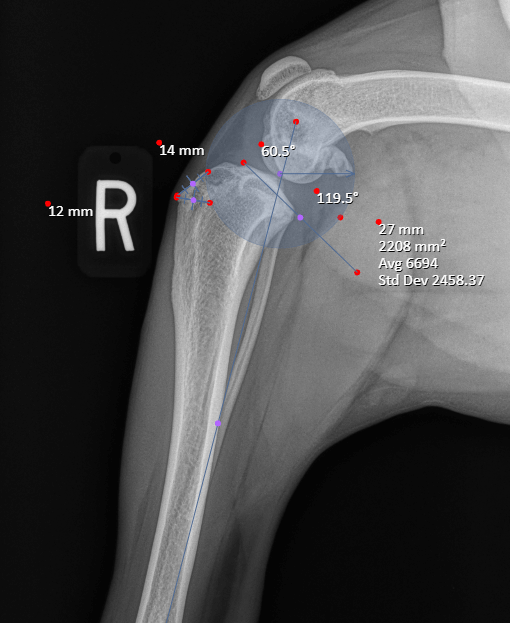
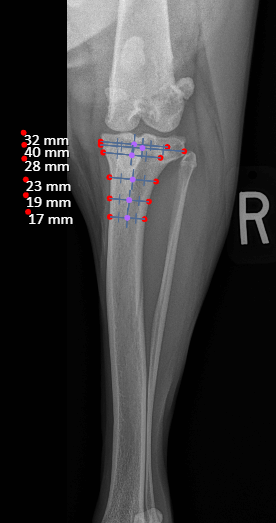
TPLO Anesthesia
An intravenous (IV) catheter is placed into one of the cephalic veins. The patient will receive IV Fluids whilst their injured leg is being shaved. The IV fluids increase the circulating volume of blood which helps maintain a normal blood pressure whilst the patient is anesthetized. Anesthesia is induced with an injection of a drug called propofol. Once the patient has fallen asleep an endotracheal tube is inserted into their trachea through their mouth to facilitate the administration of oxygen and a gaseous anesthetic. Sensors are hooked up to the patient to allow measurement of the pet's heart rate, ECG trace, blood pressure, end-tidal carbon dioxide levels. We have Cardell monitors in our surgical prep area and in our operating room.
An epidural injection of preservative-free morphine and bupivacaine is administered to the patient. The epidural provides around 6 hours of desensitization of the pelvic limbs.
Intravenous antibiotics are started to build up the concentration of antibiotics in the patient's bloodstream.
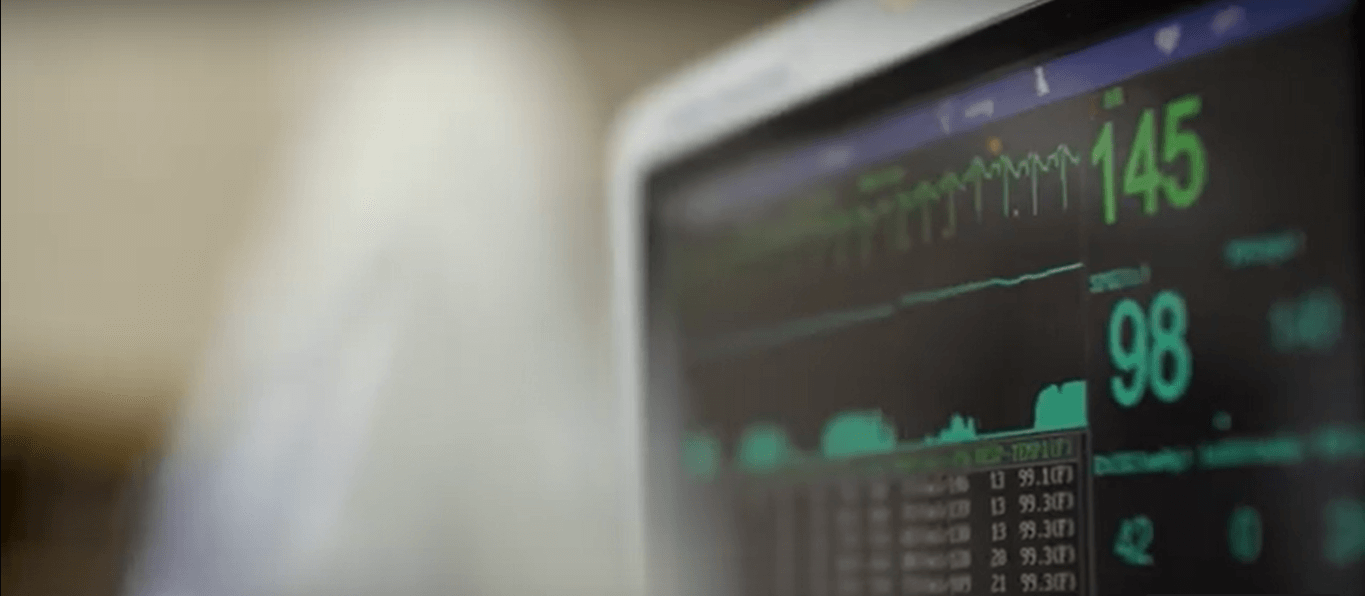
TPLO Surgical Scrub and Limb Draping
The patient is positioned on their back. A cover is placed over the unclipped hair of the paw and the leg is with their affected leg is suspended whilst the leg is aseptically prepared using a 4% chlorhexidine solution.
The patient is transferred into the operating room, where the patient is positioned for surgery and reconnected to anesthetic monitors. The ground plate for the electrocautery machine is applied to a shaved spot on the patient's thigh. Whilst the injured limb is still suspended the limb is isolated with sterile drapes. An iodine-impregnated wrap (Ioban) is applied to the limb. This aids in maintaining sterility of the operating site by preventing contact between the surgeon and the skin of the patient. Whilst the skin has been cleaned and the amount of bacteria now present on the skin has been significantly reduced there are still some bacteria present.
TPLO Incision
An incision is made through the iodine wrap on the inner side of the stifle (knee).
TPLO Joint Explore
An incision is made into the joint capsule. This procedure is called an arthrotomy. The joint is lavaged, and the internal structures are examined. Remnants of the damaged cranial cruciate ligament are removed as it serves no purpose after the joint has been stabilized, and the remnants could create a future source of pain. The medial and lateral menisci are cartilage pads that help to transfer weight from the femur to the tibia. These cartilages are examined. If damaged, then the damaged portion is removed (partial meniscectomy), or the entire meniscus may be removed (complete meniscectomy). The joint is lavaged and the joint capsule is sutured closed with a dissolvable suture.

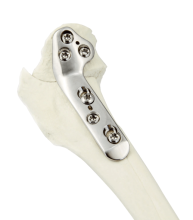 TPLO Corrective Osteotomy
TPLO Corrective Osteotomy
An osteotomy is a surgical cut in a bone. In the cruciate deficient stifle, a cut is made in the top of the tibia. The top portion of bone that contains the articular surface is rotated to level it. The Two pieces of bone are held in place with a metal plate and screws.
TPLO Post Surgical Radiographs
While the patient is still anesthetized, the patient is taken into radiology for post-surgery radiographs (X-rays). The radiographs are assessed to measure the new tibial plateau angle. We are aiming for 5-6 degrees relative to the long axis of the tibia. The apparatus (plate and screws) are assessed for size and appropriate position.

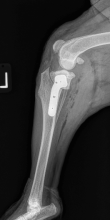
TPLO Recovery From Anesthesia
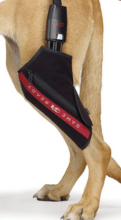 After the post-surgical radiographs have been reviewed by the surgeon, the patient is moved through to recovery. The patient's leg is cleaned, and a sports wrap that provides cold compression therapy (Game Ready) is applied to the operated limb for 30 minutes.
After the post-surgical radiographs have been reviewed by the surgeon, the patient is moved through to recovery. The patient's leg is cleaned, and a sports wrap that provides cold compression therapy (Game Ready) is applied to the operated limb for 30 minutes.
The patient is extubated and moved through to a recovery kennel. The epidural (bupivacaine and morphine) provides 6 hours of post-surgical relief for the patient. This equates to 3-4 hours of pain relief after the patient has woken up from anesthesia. After the epidural has worn off, the patient will be able to walk out to the bathroom and already be able to place weight on their operated limb. Most patients will feel good enough to enjoy a nice dinner after surgery.
TPLO Post Surgical Care
For routine procedures, the usual hospital stay is 2-3 days. We often board patients for a longer duration after surgery when their owners feel they are unable to provide the necessary care required during the recovery period.
Typical rechecks are at 2, 6 and 12 weeks. Patients come back at two weeks to have their sutures removed. Until the sutures are removed the patients will wear an E-Collar (cone of shame) to prevent them from licking at their incision. The inflatable collars do not provide sufficient protection for surgery on the knee and are not recommended.
 For the first 6 weeks after surgery, the patient will need to be confined to a small kennel or crate to prevent them from over-exercising. For the first two weeks after surgery, the patients will need to be taken out for toilet breaks (on a leash) and then returned to their crate. At two weeks, the patient will have their sutures removed, and they no longer need to wear the E-collar.
For the first 6 weeks after surgery, the patient will need to be confined to a small kennel or crate to prevent them from over-exercising. For the first two weeks after surgery, the patients will need to be taken out for toilet breaks (on a leash) and then returned to their crate. At two weeks, the patient will have their sutures removed, and they no longer need to wear the E-collar.
At two weeks after surgery the pets will be able to start going on short walks whilst being confined to their leash.
At six weeks after surgery, we will take radiographs to confirm the healing process is progressing as expected. The patient will then be able to move around within the confines of the house without being kept in a crate. Outside, they will still need to be kept on a leash for an additional 6 weeks. At 12 weeks after surgery, a final recheck exam and series of radiographs will be obtained. The patients will be cleared at this visit to resume activity off-leash.
How much does TPLO surgery cost?
$4,450 - $5,450*
This includes an orthopedic exam, pre-operative blood work, pre and post-surgical radiographs, anesthesia, surgical time, hospitalization, game-ready cold compression therapy, post-operative pain relief, and standard recheck examinations.
*Pricing based on standard repair procedure, and patient body weight being less than 140.0 lbs at the time of procedure. All prices quoted are based on the average procedure. For a specific price quote for your pet please call our office so we can confirm accurate, up to date pricing.
Want to learn more about how we can help your dog? Request an appointment now!
You may also contact our office at (209) 287-3222 or email us at [email protected]
Reviews from TPLO Surgery:
"Dr Ned & Staff, Thank you so much for the quality , loving care you provided Molly over the past few months! She (& I) Truly appreciate all that you did for her.
- Matt & Molly Kaufmann" 11.15.2019
"We rescued a dog and within only 4 months she had torn her knee ligament. We were shocked and upset that the only option was surgery and that would be $6,000!!!! We had a friend who went to Oakdale Vet Group for the same exact thing, and we decided to have a consult. Dr Trathan was able to schedule the surgery within 2 weeks (time was of the essence since there is a huge possibility of her other leg tearing because of her weight and the extra strain. We LOVED Dr. Trathan, and the whole staff-every single person was so professional and the facility looked clean and legit. We ended up going into TPLO surgery for her hind leg and we had the best possible experience under those circumstances. We paid half the price because he does this type of surgery so much, he has streamlined what works and made it quicker and easier with his techniques so the cost isn't has high (plus its a little further from the Bay Area). Our other dog is almost totally recovered 2 months later and healing beautifully. They really took care of us and made this terrible thing as easy and trauma free as it can be. We were not happy about spending so much money on our dogs injury but Dr Trathan and the staff made every penny worth it. Now our dog can walk, run and live the active lifestyle with us that we got her for. Thank you Dr. Trathan.
- Aimee A" 03.01.2019
"Dr Ned is the greatest!! He did TPLO Surgery on my border Collie, got her in within a couple of days of my first call, did the consult and I left her there the same day for surgery the following morning, he kept her for 2 days and would have kept her for 3 but I didn't want to leave her that long. He explains everything in detail and you can tell her really cares about animals. His staff is really great too.!! I drove an hour and a half an it was totally worth it!! Thank you Dr Ned!!
- Darla H" 10.12.2019
"Affordable estimates for TPLO surgery, compared with other hospitals in the Bay Area. The staff provided routine updates on my pets well-being with very well taken photos to share. Dr Ned Provided all the details and care instructions to perform after the surgery, as well as a direct line for any urgent questions. I'll recommend this hospital for any orthopedic related pet surgery.
- Wayne L" 09.27.2019
"Dr Ned Trathan did TPLO Surgery on my dog KC...he did such a great job that she is back to 100% and you'd never know she was injured. He and his staff did a great job and were so accommodating in drop off and pick up since I don't live close. I traveled from Castro Valley to get there. I highly recommend them :)
- Diane S" 02.21.2019
